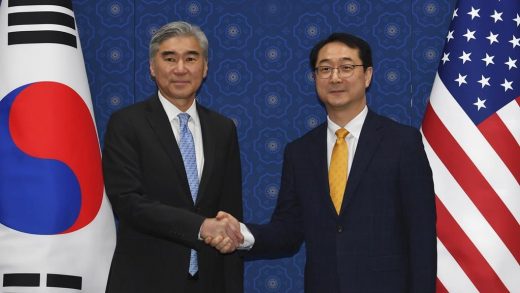:format(webp)/https://www.thestar.com/content/dam/thestar/entertainment/2023/07/06/were-you-a-fan-of-degrassi-mr-dressup-or-polka-dot-door-a-new-exhibit-celebrates-groundbreaking-made-in-toronto-tv/main_myseum_toronto_exhibit_dressup_degrassi.jpg)
Maybe you spent your weekday mornings with the Friendly Giant, Jerome and Rusty. Or your Tuesday and Thursday evenings with Jeff, Jodie, Sam and Muffy Mouse.
If you walk into the Myseum of Toronto right now, chances are those days of watching your favourite show sprawled in front of a television — yes, a TV, not a computer screen or a phone — will come flooding back.
The space at 401 Richmond St. W. is the site of the exhibit “Mr. Dressup to Degrassi: 42 Years of Legendary Toronto Kids TV.” It’s a treasure trove of nostalgia for children’s shows that aired between 1952 and 1994, including the two cited above, “The Friendly Giant” (1958 to 1985) and “Today’s Special” (1981 to ’87).
If the word “legendary” in the title raises your eyebrows, curator Ed Conroy can explain just how revolutionary some of the children’s TV being made in Toronto during those decades really was.
When CBLT, Canada’s first English-language TV station, started broadcasting in September 1952, “television was seen as this very low art form,” said Conroy, a cultural historian who’s the founder of Retrontario, which collects and preserves the televisual history of Toronto and Ontario.
“Most of the people in the entertainment industry were focused on motion pictures, on theatre and on radio, and television was where all the losers went,” he continued. “Children’s television was even below that. But, because of that, it allowed for this great experimentation and a lot of very eclectic characters … You see how ahead of their time (they were).”
Conroy mentions “Razzle Dazzle,” a 1961 kids’ variety show on CBC that was in some ways a precursor of YouTube or TikTok.
“What’s fascinating to me (is) how much of it was basically user-generated content. They had kids writing them letters and jokes, and they would do segments that were written by viewers. That’s obviously such a huge part of the entertainment ecosystem now.”
Did you know that “The Uncle Bobby Show” (later “Playtime With Uncle Bobby” and “Uncle Bobby and Friends”) which aired on CFTO from 1964 to 1979, was the first children’s show in North America to feature sign language? Shot in Agincourt, it starred British-born former vaudevillian Bobby Ash.
Consider also that TVO’s “Polka Dot Door” (1971 to 2000) was the first Canadian TV series with episodes hosted exclusively by people of colour, with the late Denis Simpson and Tonya Williams, who went on to become a soap opera star in “The Young and the Restless.”
Conroy also name-checks Fred Rainsberry, the former head of children’s programming at the CBC who brought Mister Rogers, Mr. Dressup and the Friendly Giant to Canada.
True, Fred Rogers didn’t stay: after making “Misterogers” in the early 1960s for the CBC, he went back to the U.S. and launched “Mister Rogers’ Neighborhood” in ’68. But his friend and co-worker, U.S.-born puppeteer Ernie Coombs, stuck around and became the host of “Mr. Dressup,” which ran from 1967 to 1996. Bob Homme, another American invited to Canada by Rainsberry, transferred “The Friendly Giant” from Wisconsin to Toronto. It ran from 1958 to 1985.
Conroy sees Rainsberry as just important a figure in Canada’s media landscape as Marshall McLuhan or Moses Znaimer.
“He was a schoolteacher from Enniskillen, Ontario, and he was writing about television, specifically children’s television, long before there was any kind of media about the genre. He was very McLuhanesque in that he saw it as this incredible opportunity,” Conroy said.
“A lot of people said television is gonna corrupt the minds of the youth … And he said, no, this is the opposite. This can be a force for social change, for education.”
When Rainsberry started with the CBC in the 1950s, it was airing American kids’ shows like “Howdy Doody,” which Conroy said were “sort of condescending to children.”
With Rainsberry’s influence and that of the people he recruited, “the Canadian shows were much more talking to children as if they were talking to their friends. And I think that kids responded to ‘Misterogers” and ‘Mr. Dressup’ and ‘Friendly Giant,’ because it was not a grown-up talking down to them.”
Those shows are represented, of course, in “Mr. Dressup to Degrassi” — the latter “the greatest contribution that Toronto gave to the world in terms of children’s television” in Conroy’s view — along with a couple dozen others.
The exhibit includes a replica of the Friendly Giant’s castle wall and the miniature furniture he’d arrange for his viewer guests. Alas, puppets Jerome the giraffe and Rusty the chicken are no longer in Toronto, having been reclaimed from the CBC by the children of the late Bob Homme after they were used in a 2007 Gemini Awards sketch that they felt disrespected their father’s legacy.
But if puppets are part of your childhood TV memories, there’s plenty else to see. The exhibit is chronologically bookended, in fact, by two green puppets.
A cranky puppet called Uncle Chichimus was the first thing viewers saw when CBLT launched in ’52 — after an upside down network logo — as he introduced a show called “Let’s See.”
“It was meant to be sort of a grotesque puppet for grown-up stuff, but he then acquired a cult audience amongst kids and then (‘Let’s See’) turned into a kids’ show,” Conroy said.
Unfortunately, there is no surviving footage of Uncle Chichimus, according to Conroy, but it’s worth noting that “Let’s See” represented the first time a puppeteer appeared on TV without a puppet stage, predating the groundbreaking work of Jim Henson and “Sesame Street.”
“And then the end point we chose (for the exhibit), 1994, because that was when the internet had started, and a lot of independent broadcasters were acquired by larger corporations and things started to become very globalized,” said Conroy.
But YTV did a programming stunt on New Year’s Day, 1994, in which the channel was hijacked by puppets called the Grogs.
“Warren Grog is this sort of grotesque green puppet. He was just showing whatever he wanted to show for the full day,” Conroy said. “And then at the end, the real hosts took back control of the signal and everything went back to normal. But it was really never the same after that. It was a very punk rock thing to do.”
Luckily, the Grog puppets are part of the exhibit, as are original puppets from “Today’s Special” and “Bookmice” (1991), lent by puppeteer and voice actor Nina Keogh, as well as very good replicas of Casey and Finnegan from “Mr. Dressup.”
Conroy said Keogh was an invaluable resource for the exhibit because of her history with children’s TV.
She began training with her puppeteer parents John and Linda Keogh on “The Friendly Giant,” and went on to work on beloved shows like “Mr. Dressup,” “Polka Dot Door” and “Today’s Special.”
That last program has special resonance for Conroy. As a child, he was a huge fan of the series, which was filmed mainly in the former Simpsons department store in downtown Toronto (now the Bay), and “every time my mom would take me to the Eaton Centre I’d go looking to see if I could find the characters. There was just something really wonderful about that, that as a kid you could watch a program and know that it was all set in Toronto.”
“Mr. Dressup to Degrassi” sticks to shows made in Toronto, so you won’t see popular titles like “The Hilarious House of Frightenstein” or “You Can’t Do That on Television” since those programs were made in Hamilton and Ottawa, respectively.
But there is still plenty to stir your memories and keep your interest, particularly given the fleeting nature of that early TV.
“Kids are saying now, because of the technology, if they see something they like on YouTube or on Disney Plus they can just watch it a million times,” said Conroy. “But back then, you saw that episode of ‘Polka Dot Door’ and then you never saw it ever again …
“Unfortunately, a lot of these shows weren’t archived. They were seen as being not really valuable, and they either reused the tapes or they just junked them.”
But on a visit to the Myseum, you fight feel like you’re walking through your own polka dot door as you immerse yourself in the rich history of children’s TV in Toronto.
JOIN THE CONVERSATION
does not endorse these opinions.
:format(webp)/https://www.thestar.com/content/dam/thestar/entertainment/2023/07/06/were-you-a-fan-of-degrassi-mr-dressup-or-polka-dot-door-a-new-exhibit-celebrates-groundbreaking-made-in-toronto-tv/ed_conroy_myseum_toronto_exhibit.jpg)
:format(webp)/https://www.thestar.com/content/dam/thestar/entertainment/2023/07/06/were-you-a-fan-of-degrassi-mr-dressup-or-polka-dot-door-a-new-exhibit-celebrates-groundbreaking-made-in-toronto-tv/mister_rogers_childrens_tv_myseum_toronto.jpg)
:format(webp)/https://www.thestar.com/content/dam/thestar/entertainment/2023/07/06/were-you-a-fan-of-degrassi-mr-dressup-or-polka-dot-door-a-new-exhibit-celebrates-groundbreaking-made-in-toronto-tv/robert_homme_friendly_giant_myseum_toronto.jpg)



